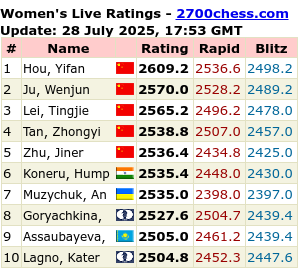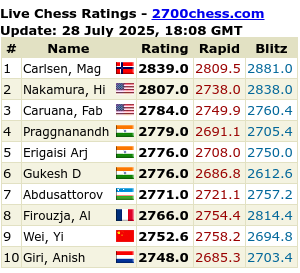During the third round of the Malaysian Chess Open 2009, GM Negi Parimarjan, India,(2590) met Pak Yevgeniy (2359) on the 24th August 2009.
A Classical Sicilian opening was chosen by Black. As the game continued, GM Negi slowly strangles the Black pieces and limiting the Black King to its back rank, forcing zugswang any move made by Black. At move 56, Black resigned.
After round 8, GM Negi is positioned in second place with 6 points from 8 games, just a half point behind leader, Senador Emmanuel of the Philippines. Fittingly, in the penultimate round of the Malaysian Open 2009, both these players will meet each other on first board to decide who wins the tournament. However, 8 other players are also on 6 points, so both Senador or GM Negi must go for a win in the last round to ensure maximum points and tie-break points to be the champion and win the prize money. Best of luck to you guys, may the best player win.
(2) GM Negi,Parimarjan (2590) - Pak,Yevgeniy (2359) [B56]
Dato Arthur Tan Malaysian Open CitiTel Midvalley Megamall, K (3), 2009
[Fritz 11 (3m)]
B56: Classical Sicilian: Unusual Lines 1.e2-e4 c7-c5 2.Ng1–f3 Nb8-c6 3.Nb1–c3 d7-d6 4.d2-d4 c5xd4 5.Nf3xd4 Ng8-f6 6.h2-h3 e7-e5 7.Nd4-e2
Here, GM Negi chose a slightly different move. Usual would be 7. Ndb5....
b7-b5N
[ Some games from the database showed that 7...Bc8-e6 was winning for Black. And if White played 8.Bc1-g5, the game would be about equal or drawish. If Black continued with 8. .....d6-d5, Black is winning as shown in games below.
7...Bc8-e6 8.g2-g4 (8.f2-f4 Nf6-h5 9.g2-g3 e5xf4 10.Bc1xf4 Bf8-e7 11.Qd1–d2 Nc6-e5 12.Ne2-d4 Nh5xf4 13.Bf1–b5+ Be6-d7 14.g3xf4 Be7-h4+ 15.Ke1–e2 Ne5-c6 16.Nd4-f3 0–0 17.Ra1–d1 Bh4-e7 18.Nc3-d5 Rf8-e8 19.Ke2-f1 Be7-f8 20.Bb5-d3 Qd8-c8 21.Qd2-g2 Re8-e6 22.f4-f5 Re6-h6 Movsesian,S (2555)-Peptan,C (2460)/Groningen 1997/CBM 062 ext/1–0 (49);
8.Bc1–g5 Bf8-e7 9.Ne2-g3 0–0 10.Bf1–d3 h7-h6 11.Bg5-c1 d6-d5 12.e4xd5 Nf6xd5 13.Nc3xd5 Qd8xd5 14.0–0 Nc6-b4 15.Ng3-f5 Be7-f6 16.Nf5-e3 Qd5-c6 17.Ne3-g4 Be6xg4 18.Qd1xg4 Nb4xd3 19.c2xd3 Rf8-d8 20.Bc1xh6 Rd8-d4 21.Qg4-g3 Ra8-d8 22.Bh6-e3 Rd4xd3 Kurajica,B-Benko,P/Wijk aan Zee 1970/MCD/½–½)
8...d6-d5 9.e4xd5 Nf6xd5 10.Bf1–g2 Nd5xc3 11.Ne2xc3 Qd8xd1+ 12.Nc3xd1 h7-h5 13.Nd1–e3 0–0–0 14.c2-c3 Bf8-e7 15.Bg2-f3 h5xg4 16.h3xg4 Rh8xh1+ 17.Bf3xh1 g7-g6 18.Bh1–e4 Be7-g5 19.Be4-f3 f7-f5 20.g4xf5 g6xf5 21.Ne3-f1 Bg5-h4 22.Bc1–e3 Jeney,F-Szilagyi,G/Budapest 1950/EXT 2006/0–1 (37); 7...Bf8-e7 8.g2-g4 0–0 9.Bc1–e3 b7-b5 10.g4-g5 Nf6-e8 11.Qd1–d2 Nc6-a5 12.b2-b3 Bc8-b7 13.Ne2-g3 f7-f5 14.g5xf6 Ne8xf6 15.Bf1xb5 d6-d5 16.Nc3xd5 Bb7xd5 17.e4xd5 Nf6xd5 18.Ng3-e4 Nd5xe3 19.Qd2xe3 Rf8-f4 20.Bb5-d3 Na5-c6 21.c2-c3 Qd8-a5 22.0–0 Pisk,P (2310)-Furman,B (2245)/Karvina 1998/EXT 2000/1–0 (46); 7...d6-d5 8.e4xd5 Nc6-b4 9.Bc1–g5 Nb4xd5 10.Nc3xd5 Qd8xd5 11.Qd1xd5 Nf6xd5 12.0–0–0 Bf8-e7 13.Bg5xe7 Nd5xe7 14.Ne2-c3 a7-a6 15.Nc3-e4 Ne7-c6 16.Ne4-d6+ Ke8-e7 17.c2-c3 Rh8-d8 18.Nd6xc8+ Ra8xc8 19.Bf1–d3 Rd8-d6 20.Bd3-e4 Rc8-d8 21.Rd1xd6 Rd8xd6 22.Rh1–e1 Suarez,J-Pugach,M/Buenos Aires 1963/MCD/½–½ (53);
¹7...Bc8-e6!?³ has some apparent merit]
8.Nc3xb5 Qd8-a5+? [8...Bc8-e6!? is worthy of consideration 9.Ne2-g3 a7-a6²] 9.Ne2-c3± Bc8-b7 [9...Bc8-e6 10.Nb5xd6+ Bf8xd6 11.Qd1xd6±] 10.Bc1–d2+- [10.Nb5xd6+?! Bf8xd6 11.Qd1xd6 Nf6xe4=]
10...Qa5-d8 11.Nc3-d5 Nf6xd5 12.e4xd5 Nc6-b8 13.c2-c4 Bf8-e7 14.Bf1–d3 0–0 15.0–0 [15.Qd1–g4 g7-g6+-]
15...Nb8-d7 16.Kg1–h1 [16.Qd1–c2!? g7-g6 17.b2-b4+-]
16...f7-f5± 17.f2-f4 [17.Bd2-b4 Qd8-b6 18.Qd1–d2 a7-a5²]
17...a7-a6² 18.Nb5-c3 e5-e4 Black threatens to win material: e4xd3 19.Bd3-e2 a6-a5 20.Bd2-e3 In the style of Nimzovich 20...Bb7-a6 [20...Nd7-c5 21.Nc3-a4²]
21.Nc3-a4 Ra8-b8 22.Ra1–b1 Nd7-c5 [22...Qd8-c7 23.Qd1–d 2²] 23.Na4xc5± d6xc5 24.b2-b3 Rf8-f6 25.Qd1–d2 Ba6-c8 26.Rf1–d1 Rf6-g6 27.a2-a3 Qd8-c7 28.Rd1–c1 h7-h6 29.Qd2-e1 Kg8-h7 [29...Bc8-d7 30.b3-b4±]
2²] 23.Na4xc5± d6xc5 24.b2-b3 Rf8-f6 25.Qd1–d2 Ba6-c8 26.Rf1–d1 Rf6-g6 27.a2-a3 Qd8-c7 28.Rd1–c1 h7-h6 29.Qd2-e1 Kg8-h7 [29...Bc8-d7 30.b3-b4±]
30.Be2-h5 Rg6-a6 31.b3-b4! taking the lead.
A Classical Sicilian opening was chosen by Black. As the game continued, GM Negi slowly strangles the Black pieces and limiting the Black King to its back rank, forcing zugswang any move made by Black. At move 56, Black resigned.
After round 8, GM Negi is positioned in second place with 6 points from 8 games, just a half point behind leader, Senador Emmanuel of the Philippines. Fittingly, in the penultimate round of the Malaysian Open 2009, both these players will meet each other on first board to decide who wins the tournament. However, 8 other players are also on 6 points, so both Senador or GM Negi must go for a win in the last round to ensure maximum points and tie-break points to be the champion and win the prize money. Best of luck to you guys, may the best player win.
(2) GM Negi,Parimarjan (2590) - Pak,Yevgeniy (2359) [B56]
Dato Arthur Tan Malaysian Open CitiTel Midvalley Megamall, K (3), 2009
[Fritz 11 (3m)]
B56: Classical Sicilian: Unusual Lines 1.e2-e4 c7-c5 2.Ng1–f3 Nb8-c6 3.Nb1–c3 d7-d6 4.d2-d4 c5xd4 5.Nf3xd4 Ng8-f6 6.h2-h3 e7-e5 7.Nd4-e2
Here, GM Negi chose a slightly different move. Usual would be 7. Ndb5....
b7-b5N
[ Some games from the database showed that 7...Bc8-e6 was winning for Black. And if White played 8.Bc1-g5, the game would be about equal or drawish. If Black continued with 8. .....d6-d5, Black is winning as shown in games below.
7...Bc8-e6 8.g2-g4 (8.f2-f4 Nf6-h5 9.g2-g3 e5xf4 10.Bc1xf4 Bf8-e7 11.Qd1–d2 Nc6-e5 12.Ne2-d4 Nh5xf4 13.Bf1–b5+ Be6-d7 14.g3xf4 Be7-h4+ 15.Ke1–e2 Ne5-c6 16.Nd4-f3 0–0 17.Ra1–d1 Bh4-e7 18.Nc3-d5 Rf8-e8 19.Ke2-f1 Be7-f8 20.Bb5-d3 Qd8-c8 21.Qd2-g2 Re8-e6 22.f4-f5 Re6-h6 Movsesian,S (2555)-Peptan,C (2460)/Groningen 1997/CBM 062 ext/1–0 (49);
8.Bc1–g5 Bf8-e7 9.Ne2-g3 0–0 10.Bf1–d3 h7-h6 11.Bg5-c1 d6-d5 12.e4xd5 Nf6xd5 13.Nc3xd5 Qd8xd5 14.0–0 Nc6-b4 15.Ng3-f5 Be7-f6 16.Nf5-e3 Qd5-c6 17.Ne3-g4 Be6xg4 18.Qd1xg4 Nb4xd3 19.c2xd3 Rf8-d8 20.Bc1xh6 Rd8-d4 21.Qg4-g3 Ra8-d8 22.Bh6-e3 Rd4xd3 Kurajica,B-Benko,P/Wijk aan Zee 1970/MCD/½–½)
8...d6-d5 9.e4xd5 Nf6xd5 10.Bf1–g2 Nd5xc3 11.Ne2xc3 Qd8xd1+ 12.Nc3xd1 h7-h5 13.Nd1–e3 0–0–0 14.c2-c3 Bf8-e7 15.Bg2-f3 h5xg4 16.h3xg4 Rh8xh1+ 17.Bf3xh1 g7-g6 18.Bh1–e4 Be7-g5 19.Be4-f3 f7-f5 20.g4xf5 g6xf5 21.Ne3-f1 Bg5-h4 22.Bc1–e3 Jeney,F-Szilagyi,G/Budapest 1950/EXT 2006/0–1 (37); 7...Bf8-e7 8.g2-g4 0–0 9.Bc1–e3 b7-b5 10.g4-g5 Nf6-e8 11.Qd1–d2 Nc6-a5 12.b2-b3 Bc8-b7 13.Ne2-g3 f7-f5 14.g5xf6 Ne8xf6 15.Bf1xb5 d6-d5 16.Nc3xd5 Bb7xd5 17.e4xd5 Nf6xd5 18.Ng3-e4 Nd5xe3 19.Qd2xe3 Rf8-f4 20.Bb5-d3 Na5-c6 21.c2-c3 Qd8-a5 22.0–0 Pisk,P (2310)-Furman,B (2245)/Karvina 1998/EXT 2000/1–0 (46); 7...d6-d5 8.e4xd5 Nc6-b4 9.Bc1–g5 Nb4xd5 10.Nc3xd5 Qd8xd5 11.Qd1xd5 Nf6xd5 12.0–0–0 Bf8-e7 13.Bg5xe7 Nd5xe7 14.Ne2-c3 a7-a6 15.Nc3-e4 Ne7-c6 16.Ne4-d6+ Ke8-e7 17.c2-c3 Rh8-d8 18.Nd6xc8+ Ra8xc8 19.Bf1–d3 Rd8-d6 20.Bd3-e4 Rc8-d8 21.Rd1xd6 Rd8xd6 22.Rh1–e1 Suarez,J-Pugach,M/Buenos Aires 1963/MCD/½–½ (53);
¹7...Bc8-e6!?³ has some apparent merit]
8.Nc3xb5 Qd8-a5+? [8...Bc8-e6!? is worthy of consideration 9.Ne2-g3 a7-a6²] 9.Ne2-c3± Bc8-b7 [9...Bc8-e6 10.Nb5xd6+ Bf8xd6 11.Qd1xd6±] 10.Bc1–d2+- [10.Nb5xd6+?! Bf8xd6 11.Qd1xd6 Nf6xe4=]
10...Qa5-d8 11.Nc3-d5 Nf6xd5 12.e4xd5 Nc6-b8 13.c2-c4 Bf8-e7 14.Bf1–d3 0–0 15.0–0 [15.Qd1–g4 g7-g6+-]
15...Nb8-d7 16.Kg1–h1 [16.Qd1–c2!? g7-g6 17.b2-b4+-]
16...f7-f5± 17.f2-f4 [17.Bd2-b4 Qd8-b6 18.Qd1–d2 a7-a5²]
17...a7-a6² 18.Nb5-c3 e5-e4 Black threatens to win material: e4xd3 19.Bd3-e2 a6-a5 20.Bd2-e3 In the style of Nimzovich 20...Bb7-a6 [20...Nd7-c5 21.Nc3-a4²]
21.Nc3-a4 Ra8-b8 22.Ra1–b1 Nd7-c5 [22...Qd8-c7 23.Qd1–d
 2²] 23.Na4xc5± d6xc5 24.b2-b3 Rf8-f6 25.Qd1–d2 Ba6-c8 26.Rf1–d1 Rf6-g6 27.a2-a3 Qd8-c7 28.Rd1–c1 h7-h6 29.Qd2-e1 Kg8-h7 [29...Bc8-d7 30.b3-b4±]
2²] 23.Na4xc5± d6xc5 24.b2-b3 Rf8-f6 25.Qd1–d2 Ba6-c8 26.Rf1–d1 Rf6-g6 27.a2-a3 Qd8-c7 28.Rd1–c1 h7-h6 29.Qd2-e1 Kg8-h7 [29...Bc8-d7 30.b3-b4±]30.Be2-h5 Rg6-a6 31.b3-b4! taking the lead.
Diagram 1. Position after white moved 31. b3-b4!
31...a5xb4 [31...a5xb4 32.a3xb4 Rb8xb4 (32...c5xb4 33.c4-c5 Passed pawn)
33.Rb1xb4 c5xb4 34.c4-c5 Passed pawn; 31...c5xb4 32.c4-c5 Passed pawn]
32.a3xb4 Ra6-b6 [32...Rb8xb4!? 33.Rb1xb4 c5xb4±]
33.b4-b5+- Bc8-d7 34.Rb1–a1 Be7-d6 35.Qe1–f2 Rb6-b7 36.Ra1–a6 Rb7-b6 37.Rc1–a1 Bd7-c8 [37...g7-g6 38.Bh5-d1+-]
38.Ra6xb6 Rb8xb6 39.Bh5-e8 Rb6-b8 40.Be8-c6 Qc7-e7 41.Ra1–b1 [¹41.g2-g3+-] 41...Qe7-c7? [This was a mistake by Black, better would be 41...Bc8-a6 42.g2-g3+-]
42.Qf2-b2 [¹42.Be3xc5!? keeps an even firmer grip 42...Bd6xc5 43.Qf2xc5 Qc7xf4+-] 42...Qc7-b6 [42...Bd6xf4 43.Be3xc5 Bc8-b7 44.Qb2-f2 Bb7xc6 45.d5xc6+-]
43.Rb1–a1 Qb6-c7 44.Qb2-f2 Qc7-e7 45.Ra1–b1 Twofold repetition 45...Qe7-a7?? gives the opponent counterplay [45...Qe7-c7 46.Be3xc5 Bd6xc5 47.Qf2xc5 Qc7xf4 48.Qc5-a7+-]
46.Qf2-b2 Qa7-b6 47.Qb2-a3 [47.Qb2-c3 Kh7-g6+-] 47...Qb6-c7 [47...Bc8-b7 48.Qa3-c3+-] 48.Rb1–f1 [48.Be3xc5!? makes it even easier for White 48...Bd6xc5 49.Qa3xc5 Qc7xf4+-] 48...Qc7-e7 49.Qa3-a5 Qe7-h4? [49...Bc8-b7 50.Qa5-a7 Bb7xc6 51.Qa7xe7 Bd6xe7 52.d5xc6+- (52.b5xc6?! Kh7-g6+-) ] 50.Kh1–h2 [50.Qa5-a7 Qh4-g3 51.Be3xc5 Bd6xf4+-]
50...Qh4-h5? [50...Qh4-e7+-]
51.Qa5-d8 Qh5-g6 52.Bc6-e8 Qg6-f6 53.Qd8xf6 g7xf6 54.Rf1–a1 Kh7-g8 [54...Kh7-g7 hardly improves anything 55.Kh2-g3 h6-h5 56.Be8xh5+-]
55.Ra1–a7 Kg8-f8 [55...Bc8-e6 does not improve anything 56.Be8-g6 (56.d5xe6?! Rb8xe8 57.Kh2-g3 Re8xe6+-) 56...Be6-c8 57.Kh2-g3+-]
56.Be8-c6 1–0.

Diagram 2. White moved 56. Bc6 and Black resigned.
With no convincing moves for Black to play, Black resigned. Another win for this young GM from India.






























No comments:
Post a Comment